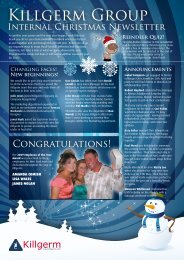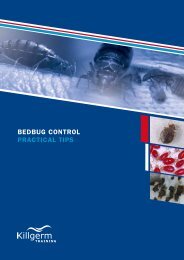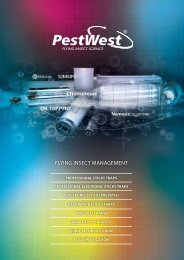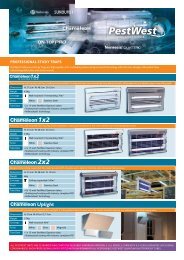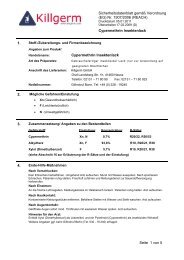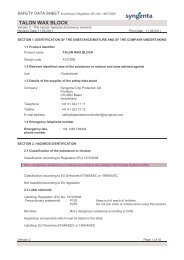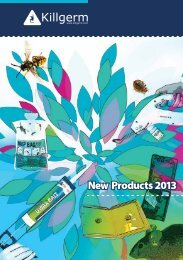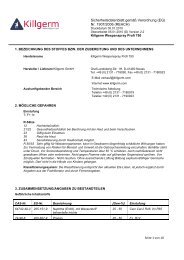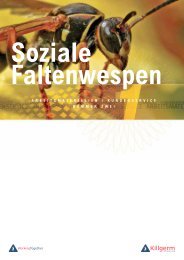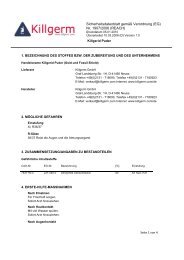Howe's Olympic Algaecide - Killgerm Chemicals Ltd
Howe's Olympic Algaecide - Killgerm Chemicals Ltd
Howe's Olympic Algaecide - Killgerm Chemicals Ltd
You also want an ePaper? Increase the reach of your titles
YUMPU automatically turns print PDFs into web optimized ePapers that Google loves.
1 Identification of the preparation<br />
and the supplying Company<br />
Safety Data Sheet Howes <strong>Olympic</strong> <strong>Algaecide</strong><br />
Howes <strong>Olympic</strong> <strong>Algaecide</strong>. A concentrated biocide for treatment of surfaces to control algae.<br />
<strong>Killgerm</strong> <strong>Chemicals</strong> <strong>Ltd</strong>, Wakefield Road, Ossett, West Yorkshire, WF5 9AJ.<br />
Tel: +44 (0)1924 268450 Fax: (0)1924 265033 Email: technical@<strong>Killgerm</strong>.com<br />
2 Hazards identification C. Corrosive – Causes burns. R34.<br />
Xn. Harmful - Harmful in contact with skin and if swallowed.<br />
N. Dangerous for the environment – Very toxic to aquatic organisms. R50.<br />
3 Composition and information on Benzalkonium Chloride solution - 66.0%w/w. C. R34. R21/22. R50.<br />
ingredients<br />
See paragraph 16 for full text of R-phrases and hazard classification of ingredients.<br />
4 First Aid measures Ingestion: Wash out mouth with water, avoid contaminating body. Remove contaminated<br />
clothing. Give small quantity of milk or water to drink. Get medical advice.<br />
Skin contact: Wash with water. Remove contaminated clothing. Re-wash skin. Get medical<br />
advice if irritation or skin-colour change symptoms occur or if contact is more<br />
than trivial (i.e.- greater than palm sized).<br />
Eye contact: Wash for 10 mins with water. Get medical advice. Avoid initial washings<br />
contaminating clothing and other parts of body.<br />
Advice to doctor: Contains surface active detergent.<br />
5 Fire-fighting measures Extinguishers: Use dry chemical or foam fire extinguishers.<br />
Toxic fumes will be evolved in a fire.<br />
Self-contained breathing apparatus should be worn by fire fighters.<br />
6 Accidental release measures Spillage (containment and<br />
disposal):<br />
7 Handling and storage Precautions in use:<br />
Storage and transport<br />
precautions:<br />
Small spillages- mop up, then mop over area with soap and water.<br />
Large spillages- Prevent spreading by surrounding with sand, earth, rags etc.<br />
Absorb, then shovel whole lot into a marked plastic container. Contact<br />
supplier for advice about disposal. Wash contaminated area with soap and<br />
water. Area may be slippery.<br />
FOR USE ONLY BY PROFESSIONAL OPERATORS.<br />
Wear suitable protective clothing, gloves and eye/face protection.<br />
Do not breathe spray. Otherwise wear respiratory protective equipment and<br />
eye protection (See HSE guidance booklet (HS)G53: “The Selection, Use and<br />
Maintenance of Respiratory Protective Equipment – A Practical Guide”).<br />
AVOID EXCESSIVE CONTAMINATION OF COVERALLS AND LAUNDER<br />
REGULARLY.<br />
TAKE OFF IMMEDIATELY all contaminated clothing.<br />
COVER WATER STORAGE TANKS before application.<br />
REMOVE OR COVER ALL FOODSTUFFS before application.<br />
UNPROTECTED PERSONS AND ANIMALS SHOULD BE KEPT AWAY<br />
FROM TREATED AREAS FOR 48 HOURS OR UNTIL SURFACES ARE<br />
DRY.<br />
REMOVE OR COVER ALL FISH TANKS AND BOWLS before application.<br />
AVOID ALL CONTACT WITH PLANT LIFE.<br />
PREVENT ANY SURFACE RUN-OFF FROM ENTERING DRAINS.<br />
This material and its container must be disposed of in a safe way.<br />
WASH ANY CONTAMINATION FROM SKIN OR EYES IMMEDIATELY.<br />
WASH HANDS AND EXPOSED SKIN before meals and after use.<br />
In case of accident or if you feel unwell, seek medical advice immediately<br />
(show the label where possible).<br />
KEEP AWAY FROM FOOD, DRINK AND ANIMAL FEEDING STUFFS.<br />
Keep out of the reach of children.<br />
Keep only in the original container. Keep container tightly closed.<br />
KEEP IN A SAFE PLACE.<br />
Use appropriate containment to avoid environmental contamination.<br />
8 Exposure controls and personal<br />
protection<br />
PPE Item In Use Spillage<br />
Respirator If required, half mask to EN140 plus<br />
AP to EN143 class filter to required<br />
protection factor.<br />
Gloves Unlined synthetic rubber/PVC gloves. Unlined synthetic rubber/PVC gloves.<br />
Overall Coverall to type 5/6 plus apron when<br />
handling the concentrate.<br />
Coverall to type 4.<br />
Goggles/ Face shield Face shield to EN166. Face shield to EN166.<br />
9 Physical and chemical properties Appearance: A pale green/yellow slightly viscous liquid.<br />
pH: Of concentrate at manufacture is between 2.0 and 7.0 the pH drops on storage<br />
but this has no effect whatsoever on the fluid properties.<br />
Flash point: None<br />
Flammability: Will not burn at ordinary temperatures. Not considered a fire hazard.<br />
Bulk density: 1.00<br />
Solubility: Soluble in water.<br />
Odour: Characteristic- slight odour.<br />
Incompatibility: Store away from strong oxidising agents.<br />
10 Stability and reactivity Not a reactive preparation.<br />
11 Toxicological information Routes of entry/symptoms of contact:<br />
Page 1 of 2 SDS: Howes <strong>Olympic</strong> <strong>Algaecide</strong> REVISION NO. 4 Issue date: April 2013
Safety Data Sheet Howes <strong>Olympic</strong> <strong>Algaecide</strong><br />
Inhalation: Risk via this contact route is very low.<br />
Skin and eyes: Irritating.<br />
Ingestion: Harmful if swallowed. Irritation to mouth, gastro-intestinal tract and stomach.<br />
12 Ecological information • Preparation is classified as (N) Dangerous for the environment. Very toxic to aquatic organisms.<br />
• The active ingredient giving rise to this classification is rapidly degraded on contact with soils, waste<br />
waters and organic matter.<br />
• Preparation is readily biodegradable and not bioaccumulable. In sewerage treatment plants,<br />
preparation is readily removed via bio elimination.<br />
• Harmful to fish and other aquatic life. Avoid all contact with plant life. Prevent any surface run-off from<br />
entering drains.<br />
13 Disposal considerations Empty containers, 5L, plastic: Controlled, non-hazardous waste. EWC code 15 01 02.<br />
Unused/recovered materials: Contact local authority waste disposal section or supplier for advice on disposal.<br />
Contaminated PPE, wipes: Low level of contamination- controlled, non-hazardous waste. EWC code 15 02<br />
03,<br />
High level of contamination- controlled waste. Contact local authority waste<br />
disposal section or supplier for advice.<br />
14 Transport information UN no. 1760. Packing Group III.<br />
Marine pollutant.<br />
Corrosive liquid, N.O.S<br />
Contains 33% benzalkonium chloride (QAT).<br />
15 Regulatory information • This preparation has been classified in accordance with The <strong>Chemicals</strong> (Hazard Information and<br />
Packaging for Supply) Regulations 2009: CHIP 4. These implement the Dangerous Preparations<br />
Directive- 99/35/EC. This Safety Data Sheet complies with CHIP 4 requirements and the Safety Data<br />
Sheets Directive 91/155/EEC (as amended by Directives 93/112/EC and 2001/58/EC).<br />
• Restricted to professional users.<br />
• Refer to other relevant measures such as the Health and Safety at Work etc Act 1974 and the COSHH<br />
regulations and guidance.<br />
• The information contained in this data sheet does not constitute the user's own assessment of<br />
workplace risks as required by legislation.<br />
• Hazard symbols: - C_ Corrosive. N_ Dangerous for the environment.<br />
• Risk phrases: - R35_ Causes burns. R21/22_ Harmful in contact with skin and if swallowed.<br />
• Safety phrases: - S2- Keep out of the reach of children.<br />
S36/37/39- Wear suitable protective clothing, gloves and eye/face protection.<br />
S45- In case of accident or if you feel unwell seek medical advice immediately<br />
(show the label where possible).<br />
• This product is approved under the Control of Pesticides Regulations 1986.<br />
16 Other information Use only in accordance with label instructions.<br />
Ingredient classification data: C_ Corrosive. N_ Dangerous for the environment. Xn_ Harmful.<br />
R34- Causes burns. R21/22- Harmful in contact with skin and if swallowed.<br />
The information in this data sheet should be considered when undertaking a risk assessment under the COSHH<br />
regulations.<br />
This data sheet does not constitute a COSHH assessment.<br />
The information contained within this data sheet is strictly for general guidance only and should not be relied<br />
upon over and above this. This data sheet is intended to provide general health and safety guidance on the<br />
handling, storage and transportation of the preparation. The information provided in this data sheet is accurate<br />
at the date of publication and will be updated as and when appropriate. No liability will be accepted by <strong>Killgerm</strong><br />
<strong>Chemicals</strong> Limited for any loss, injury or damage arising from any failure to comply with the information and<br />
advice contained within this data sheet and/or failure to comply with the manufacturer’s guidelines, product<br />
label data and any associated technical usage literature.<br />
Incorporates the REACH requirement changes to safety data sheets.<br />
Page 2 of 2 SDS: Howes <strong>Olympic</strong> <strong>Algaecide</strong> REVISION NO. 4 Issue date: April 2013



